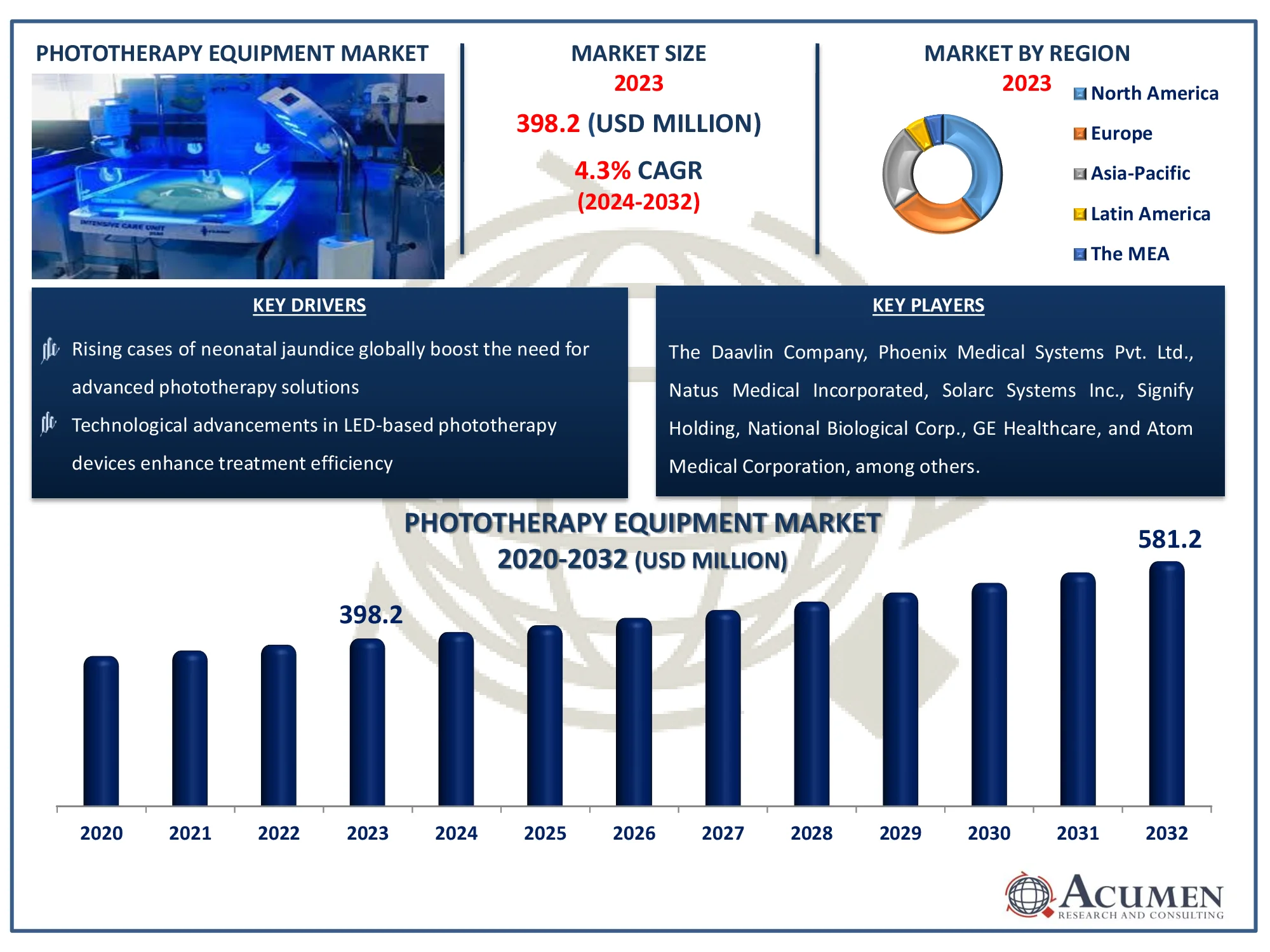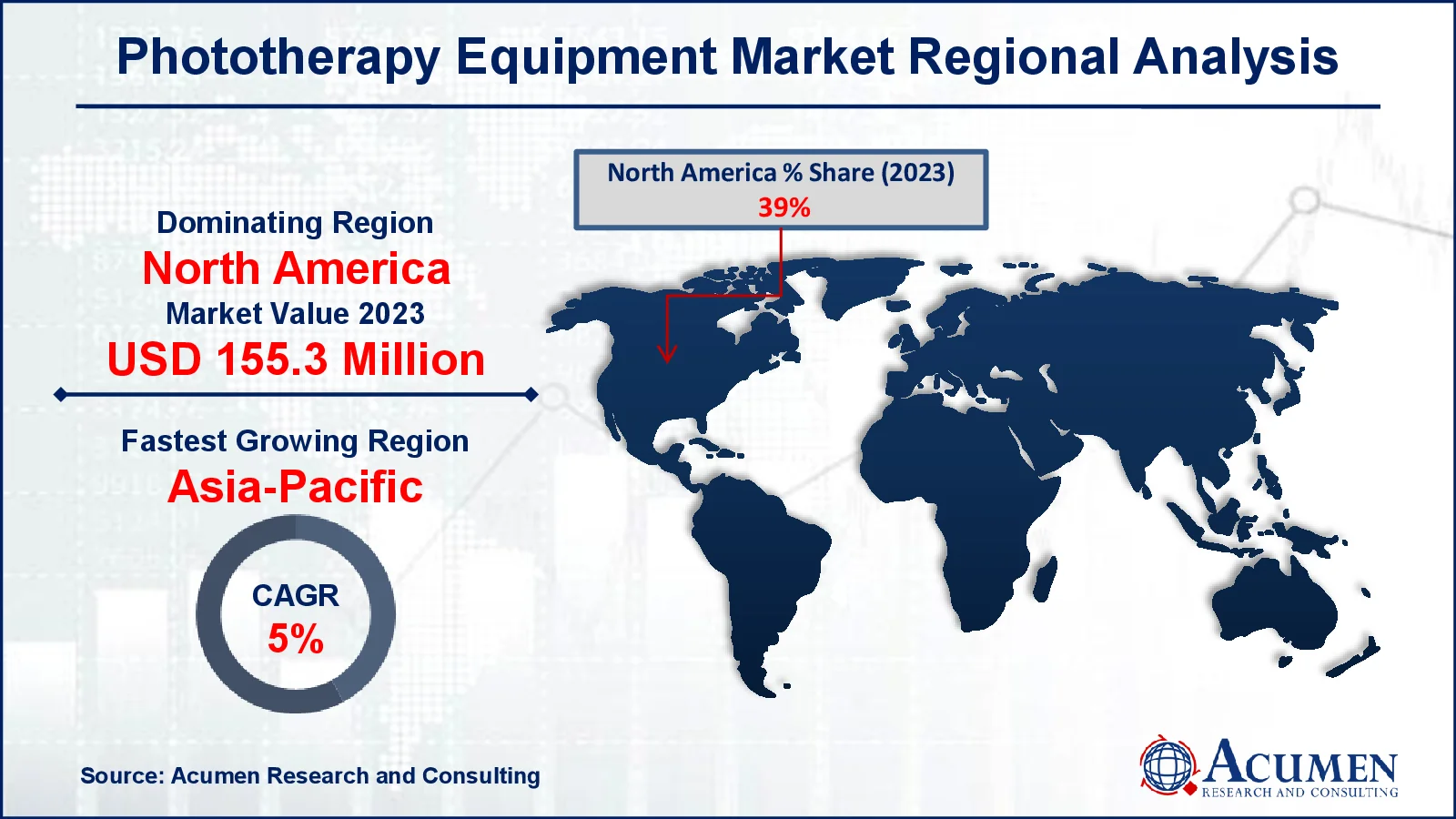August 2024
The global Phototherapy Equipment Market is expected to grow from USD 398.2 million in 2023 to USD 581.2 million by 2032, with a CAGR of 4.3%. This report provides in-depth analysis of market trends and projections.
The Global Phototherapy Equipment Market Size accounted for USD 398.2 Million in 2023 and is estimated to achieve a market size of USD 581.2 Million by 2032 growing at a CAGR of 4.3% from 2024 to 2032.
Phototherapy Equipment Market Highlights

The use of light in newborn jaundice therapy is referred to as photography. The most common method of reducing jaundice in infants is to reduce bilirubin (the substance that causes it). During phototherapy, a youngster is placed in a plastic bed and exposed to a type of light that his skin absorbs. The procedure converts bilirubin into a more water-soluble form in the infant's body, allowing it to be easily expelled through crap and urine. Moreover, the effects of neonatal jaundice and new techniques are promoting growth in the world market for photography facilities as a result of increasing research and development (R&D). Alternatives for the treatment of topical and systematic skin conditions, however, limit the growth of the world market for phototherapy equipment.
Global Phototherapy Equipment Market Dynamics
Market Drivers
Market Restraints
Market Opportunities
Phototherapy Equipment Market Report Coverage
| Market | Phototherapy Equipment Market |
| Phototherapy Equipment Market Size 2022 |
USD 398.2 Million |
| Phototherapy Equipment Market Forecast 2032 | USD 581.2 Million |
| Phototherapy Equipment Market CAGR During 2023 - 2032 | 4.3% |
| Phototherapy Equipment Market Analysis Period | 2020 - 2032 |
| Phototherapy Equipment Market Base Year |
2022 |
| Phototherapy Equipment Market Forecast Data | 2023 - 2032 |
| Segments Covered | By Product, By Application, By End Use, And By Geography |
| Regional Scope | North America, Europe, Asia Pacific, Latin America, and Middle East & Africa |
| Key Companies Profiled | The Daavlin Company, Phoenix Medical Systems Pvt. Ltd., Natus Medical Incorporated, Solarc Systems Inc., Signify Holding, National Biological Corp., GE Healthcare, Atom Medical Corporation, Nice Neotech Medical Systems Pvt. Ltd., and Hebert Waldmann GmbH & Co. KG. |
| Report Coverage |
Market Trends, Drivers, Restraints, Competitive Analysis, Player Profiling, Covid-19 Analysis, Regulation Analysis |
Phototherapy Equipment Market Insights
An increased incidence of skin conditions, such as psoriasis, eczema, and acne, is the key to the development of the industry. As reported by the American Academy of Dermatology, acne impacts nearly 50 million individuals every year in the US.Therapy for the therapy of neonatal jaundice is also very helpful. The neonates are subjected to fluorescent light in this therapy, which enables them to recover more quickly. Jaundice is prevalent among newborns, but if it lasts for a lengthy time, physicians use phototherapy to treat them. 25-50% of all babies and premature neonats develop jaundice according to the Scholars Journal of Applied Medical Sciences (SJAMS).
The demand for this machinery is therefore expected to grow in the near future also with the growing instances of newborns. Constant technological progress will also increase the development of the economy. For example, D-Rev, a non-profit design firm called Design Revolution, introduced neonatal jaundice LEDs. This unit has been shown to be more energy efficient, which is ten times longer than standard equipment and relatively less expensive. Stanford Medical Schools ' research, one of D-Rev's partners, has shown its effective implementation in jaundice therapy treatment. Because of its uniformity and ease of use, most phototherapy instruments use compact fluorescent lamps.
Phototherapy Equipment Market Segmentation
The worldwide market for phototherapy equipment is split based on product, application end use, and geography.
Phototherapy Equipment Market By Products
According to phototherapy equipment industry analysis, the broad implementation range of the conventional instruments for psoriasis and eczema-related skin conditions was also the second largest segment in 2023. The lamps and compact fluorescent lights include these. Conventional photography is a widely-used method for the therapy, and therapy of vitiligo, psoriasis and eczema for babies and preterm neonates with jaundice.
Due to the accessibility of cost-effective products, LED machinery is expected to demonstrate important development in the forecast period. The elevated effectiveness and long lasting function for the treatment of newborns that develop jaundice are other factors responsible for its development. The world's most used phototherapy sources include conventional compact fluorescent lamps. They need fewer room, more radiation and less energy than standard fluorescent lamps. Therefore, during the prediction period they are also expected to acquire important market share.
Phototherapy Equipment Market By Applications
The phototherapy equipment market is classified as skin disease therapy and jaundice management on the grounds of applications. The highest incidence of serious skin disorder such as psoriasis, eczema and acne led to the therapy with skin disease in 2023. Neonatal yellow-clotting should be seen as a result of the fastest growing amount of neonates with yellow-clotting and new item start-up for neonatal jaundice therapy over the prediction era.
Phototherapy Equipment Market By End Uses
In 2023, hospitals and clinics were leading the market and will continue to be dominant over the predictor years. The development of the segment is supported by the increased amount of Skin Care Centers both in advanced and developing nations. Furthermore, the increasing demand in the hospital for phototherapy facilities will increase instances of neonatal jaundice. During the forecast period, the Home Care team should be the largest CAGR. Phototherapy at home is cost-effective and is expected to drive demand in home therapy environments.
Phototherapy Equipment Market Regional Outlook
North America
Europe
Asia-Pacific
Latin America
The Middle East & Africa

Phototherapy Equipment Market Regional Analysis
North America dominated the market in 2023, owing to the increasing prevalence of acne-related illnesses. This region also has a high level of acceptance for high-tech skin care gadgets. Due to an increase in the incidence of skin diseases such as psoriasis, vitiligo, and acne, the phototherapy business in Europe will grow at a lucrative rate during the forecast cycle. Due to increasing knowledge of sophisticated phototherapies and developing health infrastructure in nations like Asia, India and Indonesia, the Asia-Pacific region is expected to show the greatest growth rate during the phototherapy equipment market forecast period.
Additionally there is anticipated to be an increase in the incidence of neonatal jaundice and demand for cost-effective appliances in this region. Government focus on skin diseases and their therapy choices in the North America area is expected to promote market growth in the region.
Phototherapy Equipment Market Players
Some of the top phototherapy equipment companies offered in our report include The Daavlin Company, Phoenix Medical Systems Pvt. Ltd., Natus Medical Incorporated, Solarc Systems Inc., Signify Holding, National Biological Corp., GE Healthcare, Atom Medical Corporation, Nice Neotech Medical Systems Pvt. Ltd., and Hebert Waldmann GmbH & Co. KG.
Looking for discounts, bulk pricing, or custom solutions? Contact us today at sales@acumenresearchandconsulting.com
August 2024
May 2018
September 2022
January 2024